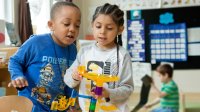7 Ideas From Reggio Emilia That Any Early Childhood Teacher Can Use
How to adapt principles from the famed approach to foster interest-based learning for the youngest students.
Twenty years ago, I learned something that changed my life. I was in an undergraduate class, and my mentor and professor shared slides about the schools of Reggio Emilia. At that moment as a teacher in training, I immediately found purpose and passion for what was possible through education.
Twenty years later, I am still as passionate about the Reggio Emilia approach as I was back then. Working in two Reggio-inspired schools and traveling to Italy twice to visit the birthplace of this teaching philosophy have given me opportunities to learn more about what this practice is, and how it looks, feels, and sounds.
Reggio Emilia is a child-centered approach to early childhood education that was developed in a northern Italian town of the same name shortly after World War II, and Reggio-inspired practice is a teacher’s and/or school’s interpretation of the Reggio Emilia approach. It will look different outside of Italy because the people and culture and history are what make it. That’s why we use the phrase “Reggio-inspired practice”—we’re inspired by Reggio to support our own context.
Every person and every school that becomes inspired will take various ideas for their own. In fact, any school can learn from this approach.
Reggio Emilia Principles That Other Schools Can Embrace
1. Image of the child: In Reggio Emilia, there is a phrase, “image of the child.” It’s what we believe about children and is at the center of my work. I believe that all children are capable, competent, and creative.
Tip: Write down three words that you believe about children and tape them somewhere obvious. Use those words to guide the day, the activities, and the environment.
2. Project work: Responding to children’s interests helps bring authentic engagement and exploration to life. Project work fosters in-depth studies that the children and teacher(s) are living and learning alongside each other. Listening well, leading with questions, and exploring—using experience, materials, hands-on learning, and integrating content areas—all create opportunities to learn in deeply integrated ways throughout the day.
Tip: Notice what the children are talking about, what they are playing, and if there are patterns or excitement around that topic. Ask what the children already know about that topic, or maybe ask the children what they are curious about. Follow up with questions they have about the topic, and start exploring those questions.
3. 100 languages: In Reggio Emilia, “100 languages” refers to the fact that children learn in many different ways, and it’s important to offer multiple opportunities for children to show what they know. It might be through reading, writing, creating a sculpture, painting, or hiking. Having various ways to create and construct offers children multiple ways to learn.
Tip: Ask the children what they like to do. If, for example, you have a lot of children who like to draw, maybe offering experiences with clay, watercolor, or loose parts can engage the children in deeper ways through a medium that excites them.
4. Environment as the third teacher: How does your environment reflect all learners? How does it invoke wonder, beauty, and engagement so that the children feel excited to enter? In Reggio Emilia, “environment as the third teacher” is an idea that allows us to think critically about how we are setting up the environment so that all children can learn.
Tip: The thinking of the children should be on the walls. Put up their math strategies, artwork, and photographs. Put up stories they have written in the book area. All of this shows that you think their work is valuable enough that it should be shared.
5. Teacher as learner: Even though I have been focused on my learning and teaching practices over the last 20 years, I still feel like I am learning something new about Reggio-inspired practice every day. Through reading, collaborating, and thinking alongside the children, I learn more. We, as teachers, should see ourselves as learners and researchers so that we can be in a space of process and active learning.
Tip: Write down what the children say in order to be inspired about what you do. Carry around a clipboard, and write down conversations so that you have a living document that shows you are a learner.
6. Family as partner: We cannot be a school without our families. It’s important to value the relationships with families. To be able to know the child well and share that with families makes them feel seen and valued.
Tip: Find the best way to contact three to five families a week: Whether it’s by email, phone call, or text, let them know what you see their child doing. Be specific. Be authentic.
7. Documentation: Children share so many ideas and questions. It’s important that we, as teachers, document that work and make it visible so that they can see their process of thinking. We can, as observers, assess the process and learning that has taken place during the project.
Tip: Take lots of photographs. Write down students’ thoughts. Share the story and the big findings so that the various audiences (children, teachers, families, policy makers) can see the thinking that has happened.
What I have learned through my studies of Reggio-inspired practice is that everything is done with purpose and intention. We should not just do to do, but we should have intent for everything we do with children. Reggio Emilia has given me an opportunity to deepen my understanding of what teaching, learning, and living can look like. Over the years I have been studying it, I have continued to take what I have read, observed, learned, and interpreted for my own context. It’s an ongoing process that will forever be my passion.
